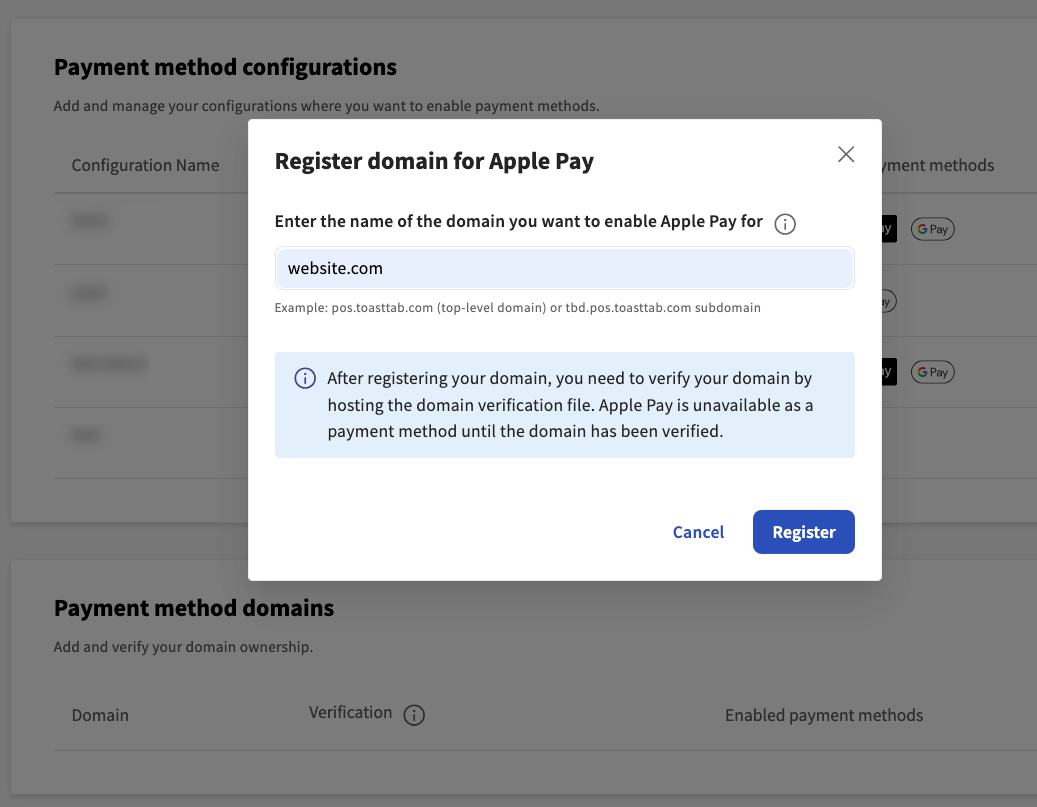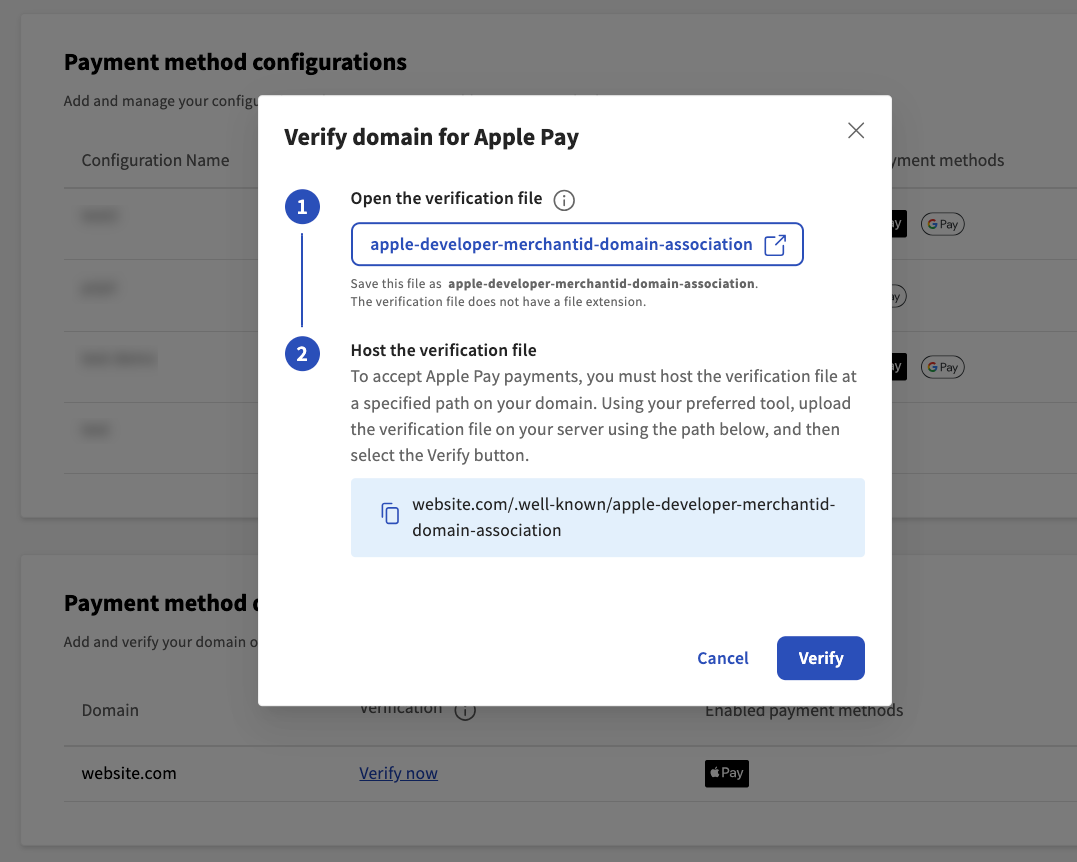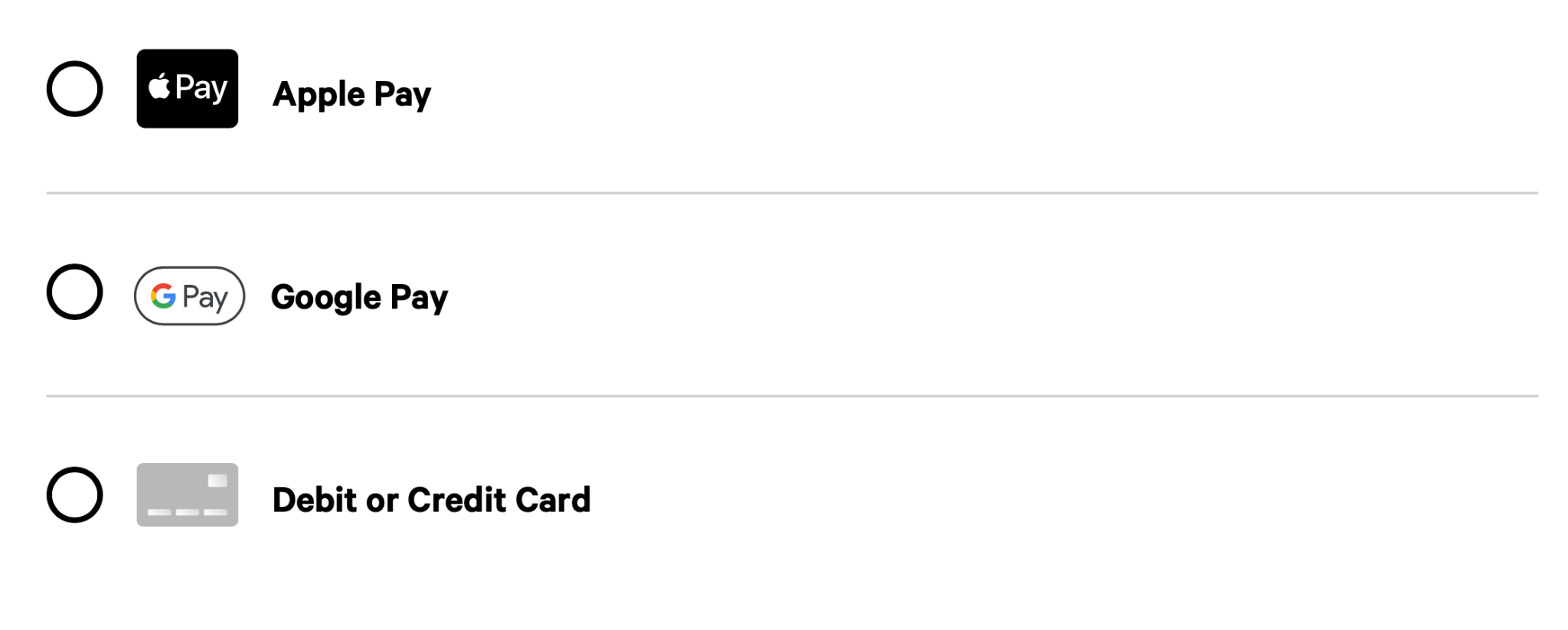The hosted checkout integration APIs support the following payment methods:
-
Keyed-in cards
-
Saved cards
-
Apple Pay®
-
Google Pay®
Some payment methods require additional setup before they can be
used with the hosted checkout integration APIs. For example, to allow
customers to use a saved card, you must create a payment intent with the
customerId. You get the customerId when you send
a POST request to the /v1/customers
endpoint of the customers API. To use Apple Pay, you must register and
validate your domains prior to completing your integration and using the
hosted checkout integration APIs. For more information, see Registering and verifying a payment method domain.
The hosted checkout integration APIs can be used to complete
keyed-in or saved card transactions. The hosted checkout integration
iframe allows customers to key in payment card details or
to pay using one of their saved cards. To create a payment intent to use
for saved card transactions, you must create a customer record. A
customer record contains information about a person or organization
making Toast payments and allows them to choose from their saved payment
cards.
To save and display a customer's saved cards, you must first
create a customer record. To create a customer record, send a
POST request to the /v1/customers
endpoint of the customers API to create a CustomerResponse.
The CustomerResponse contains the customer
description, externalReferenceId, and
id. The id is the unique identifier of the
customerId, which identifies the customer in the Toast
platform and can be used to create or update a payment intent. To
display a customer's saved cards in the iframe, include
the customerId in the request to create a payment
intent.
|
Note |
|
When a customer record is created, this does not create a customer profile in the Toast platform. The customer record is used to match the customer to their saved cards. |
Example request body
{
"externalReferenceId": "john.smith@email.com",  "description": "John Smith"
"description": "John Smith"  }
}|
Represents the customer's identity in your integration.
This can be the primary key for your customer, an unique UUID,
an email address, or any other value to help correlate the
generated
|
|||
|
A brief description of the customer, such as an email address, name, or phone number. |
Example response body
{
"id": "4b2dfc5a-88a3-11ee-b9d1-0242ac120002",  "externalReferenceId": "john.smith@email.com",
"externalReferenceId": "john.smith@email.com",  "description": "John Smith"
}
"description": "John Smith"
}|
The unique identifier for the customer record that
identifies the customer in the Toast platform and allows them to
choose from the payment cards saved to their profile. Your
integration should store the
|
|||
|
Represents the customer's identity in your integration. |
|
Note |
|
If you use the payment methods API to create a payment method,
you must integrate and support your chosen payment method types,
such as Apple Pay and Google Pay. The hosted checkout
|
As part of the hosted checkout integration, you can create a
payment method using the createPaymentMethod
SDK function. You can also choose to create a payment method by
sending a POST request to the v1/payment-methods
endpoint of the payment methods API. You can create a payment method
using the payment methods API if you want to take payments using the
Toast platform, but do not want to use the iframe to
capture customer payment card data.
|
Important |
|
If you choose to create a payment method using the payment methods API, this puts your integration and the customer’s card data under PCI scope. Compliance with PCI DSS and all other regulations or laws is solely your responsibility. The information provided is for informational purposes only and should not be relied upon or used as a substitute for consultation with a Qualified Security Assessor or other legal advisor. Please consult a professional advisor for a qualified opinion on the applicability of requirements to your business operations. |
To create a payment method, first create the payment
intent or setup intent.
Then send a POST request to the v1/payment-methods
endpoint and include the payment method type and card
details. Set the usage value to ON_SESSION
if the customer wants to save the payment method for future use.
Include the following header parameters:
-
Toast-Session-Secret: A unique and randomized identifier for the payment or setup intent. -
Toast-Idempotency-Key: An integration generated universally unique identifer (UUID) that is used to recognize retries of the same request.
Example request body
{
"type": "CARD",  "card": {
"card": {  "number": "4242424242424242",
"cvv": "123",
"expiry": {
"month": "12",
"year": "2028"
}
},
"billingDetails": {
"postalCode": "02118"
},
"usage": "ON_SESSION"
"number": "4242424242424242",
"cvv": "123",
"expiry": {
"month": "12",
"year": "2028"
}
},
"billingDetails": {
"postalCode": "02118"
},
"usage": "ON_SESSION"  }
}|
The type of payment method created. The only value is:
|
|
|
The card details used to tokenize the payment card. |
|
|
Used to determine if the customer will save the payment
method for future use. If the customer wants to save the payment
card, set the value to |
Example response body
The next step is to confirm the payment intent by sending a
POST request to the /v1/payment-intents/{paymentIntentId}/confirm
endpoint of the payment intents API. Include the identifier of the
payment method in the request body. For more information, see Confirming a payment intent.
|
Note |
|
The server component of your integration makes the API request to delete a saved payment method. |
If you allow customers to store payment cards, you can also allow them to remove payment cards by deleting the payment method from their customer record. Deleting a payment method from a customer record is permanent and the payment method cannot be reattached to their record. For more information on payment methods, see Creating a payment method.
There are two API requests associated with deleting a saved payment method from a customer record.
-
Getting a list of payment methods attached to the customer record.
-
Delete the payment method from the customer record using the
customerIdandpaymentMethodId. ThepaymentMethodIdis the unique identifier of the payment method.
To get a list of payment methods saved to a customer record,
send a GET request to the v1/customers/{customerId}/payment-methods
endpoint of the customers API using your hosted checkout - payment
credentials. You cannot use your credentials for the hosted checkout
client component of your integration. Requests made to this endpoint
using the token for your hosted checkout - iframe credentials return
an error. Include the Toast-Restaurant-External-ID as a
header parameter in the request and the customerId in
the request path.
|
Note |
|
Customers cannot save digital wallets such as Apple Pay and Google Pay as payment methods. |
Example response body
{
"results": 1,  "paymentMethods": [
"paymentMethods": [  {
"id": "f718c101-70e4-45fe-8fc1-67ba0a12a8c5",
{
"id": "f718c101-70e4-45fe-8fc1-67ba0a12a8c5",  "type": "CARD",
"cardType": "VISA",
"lastFour": "1111",
"month": "12",
"year": "27"
}
]
}
"type": "CARD",
"cardType": "VISA",
"lastFour": "1111",
"month": "12",
"year": "27"
}
]
}|
The number of payment methods attached to the customer record. |
|
|
The |
|
|
The unique identifier for the payment card. Use this
|
|
Note |
|
You must use the hosted checkout - payment credentials for the server component of your integration. |
To delete a payment method from a customer record, send a
POST request to v1/payment-methods/{paymentMethodId}/detach
endpoint of the payment methods API. Include
Toast-Restaurant-External-ID as a header parameter in
the request and the paymentMethodId in the request
path. The paymentMethodId is the identifier for the
payment card. Include the customerId in the request
body.
|
Note |
|
You cannot update the expiration date on a saved payment card. Your customer will need to add the payment card with the new expiration date and then delete the expired card. |
|
Important |
|
Apple Pay® is currently only available for Toast platform integrations on Apple’s Safari web browser. |
You can use the hosted checkout integration to accept Apple Pay
payments for orders placed on your registered domains and subdomains. To
make Apple Pay available as a payment method, you need to host the
static domain verification file, and then register and validate your
domains to complete your Apple Pay integration. The iframe,
static domain verification file, and Apple Pay registration must all be
on the same domain for Apple Pay to be available for use in the
iframe.
You can register and validate your domains on the Toast developer portal. The Payment method domains section on the Payment methods page in the Toast developer portal lists all your domains and subdomains and their verification statuses (if applicable). From the Payment method domains section, you can also choose to delete a domain or subdomain.
To accept Apple Pay payments, you must host a static domain verification file at a publicly accessible location on your domain. The static domain verification file needs to be available on each domain and subdomain used for Apple Pay transactions.
|
Important |
|
Host the static domain verification file as raw plain text. Do not apply additional formatting, extensions, or content to the file itself. |
You can download the static domain verification file for your sandbox or production environment below.
-
Sandbox: https://sandbox.eng.toasttab.com/.well-known/ME_sandbox_toast
For information about how to test Apple Pay in a sandbox environment, see Sandbox Testing.
-
Production: https://www.toasttab.com/.well-known/ME_prod_toast
The file is titled apple-developer-merchantid-domain-association. You can rename the file before you upload it to your domain.
Host the static domain verification file at the following path
on your domain:
https://[DOMAIN_NAME]/.well-known/apple-developer-merchantid-domain-association.
To register and verify a domain on the Toast developer portal
-
On the Payment methods page of the Toast developer portal, navigate to the Payment method domains section.
-
Select the + Add a new domain button to open the Register domain for Apple Pay dialog box.
-
Enter the domain name in the text field.
Note
You can create an unlimited number of payment method domains.

-
Select the Register button. After you register your domain, this creates a payment method domain record. A payment method domain record is the record of your registered domains in the Toast platform. The domain record lists all digital wallets available for use.
-
Navigate back to the Payment method domains section on the Payment methods page. Your newly registered domain is listed under the Domain heading.
-
Select the Verify now link next to the domain name to open the Verify domain for Apple Pay dialog box.
-
In the Verify domain for Apple Pay dialog, complete the following actions:
-
Open and save the static verification file at a publicly accessible location on your domain.
-
Host the static verification file at the specified path on your domain. For more information, see Preparing Merchant Domains for Verification.

-
-
Select the Verify button to verify your domain or the Cancel button to close out of the dialog box.
If the verification was successful, the domain displays Apple Pay as an enabled payment method under the Enabled payment methods heading in the Payment method domains section. If the verification was unsuccessful, an error message appears on the Verify domain for Apple Pay dialog. You will be unable to process Apple Pay transactions until Apple successfully validates the file. Make sure that the static verification file was hosted correctly on your domain.
In the Payment method domains section on the Payment methods page of the Toast developer portal, you can delete a domain by selecting the trash icon next to the domain name. This opens the Delete domain dialog box. In the Delete domain dialog box, select the Delete button to delete the domain.
If you choose to delete a payment method domain, the deletion is permanent and the domain cannot be recovered. To enable Apple Pay for the domain, you will need to re-register and verify the domain again.
|
Note |
|
For information on how to support Google Pay in your integration's WebView, see Using Android WebView and Support Android payment apps in WebView using Payment Request API. |
You can allow customers to use Google Pay® as a payment method using the
hosted checkout integration APIs. Unlike Apple Pay, Google Pay does not
require individual domain registration and is automatically enabled for
you if you choose to use the hosted checkout integration APIs to
initialize and display the iframe on your checkout
page.
You can turn Google Pay on or off in the Toast developer portal. For more information, see Managing payment method configurations.
